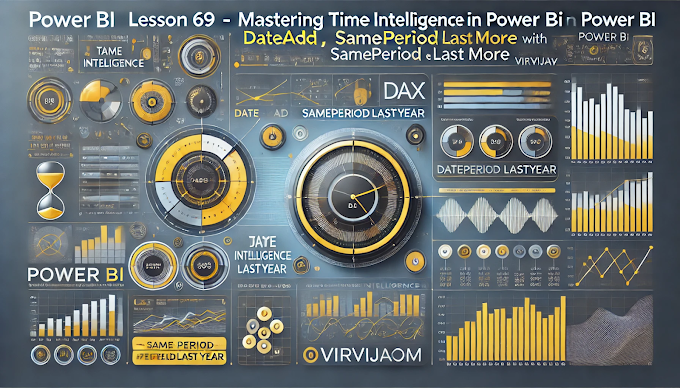Welcome back to Virvijay.com, your go-to platform for mastering Power BI! 🎯
In our last blog, we explored FILTER and ALLSELECTED to enhance data modeling. Today, we'll take a deep dive into VAR (Variables) in DAX and learn how to:
- ✔ Improve DAX code readability and efficiency
- ✔ Reduce redundant calculations
- ✔ Debug complex DAX formulas easily
1️⃣ What is VAR in Power BI?
VAR allows you to define variables in DAX before using them in a calculation. It makes your code faster, more readable, and easier to debug.
📌 Why use VAR?
- ✔ Reduces Repeated Calculations
- ✔ Improves Readability
- ✔ Enhances Performance
VAR Syntax:
DAX
VAR VariableName = Expression
RETURN Expression
- ✔ VAR VariableName → Stores a value or calculation
- ✔ RETURN → Uses the stored variable in a formula
2️⃣ Example: Using VAR to Simplify DAX Code
👉 Without VAR (Redundant Calculation):
DAX
Total Sales Growth =
SUM(Sales[Amount]) - CALCULATE(SUM(Sales[Amount]), PREVIOUSMONTH(Sales[Date]))
🚀 Problem:
✔ SUM(Sales[Amount]) is calculated twice, increasing processing time
👉 With VAR (Optimized Calculation):
DAX
VAR CurrentSales = SUM(Sales[Amount])
VAR PreviousSales = CALCULATE(SUM(Sales[Amount]), PREVIOUSMONTH(Sales[Date]))
RETURN
CurrentSales - PreviousSales
🚀 Benefits of Using VAR:
- ✔ Code is easier to read
- ✔ Improves performance by avoiding duplicate calculations
- ✔ Easy debugging – check each variable separately
3️⃣ Using VAR for Conditional Logic in Power BI
📌 Use Case: Identify high-value customers who spent more than ₹1,00,000
👉 Without VAR:
DAX
High Value Customers =
IF(SUM(Sales[Amount]) > 100000, "Premium", "Regular")
👉 With VAR:
DAX
VAR TotalSales = SUM(Sales[Amount])
RETURN
IF(TotalSales > 100000, "Premium", "Regular")
🚀 Why is this better?
- ✔ Easier to debug – test TotalSales separately
- ✔ More efficient – calculation is stored in a variable
4️⃣ Using VAR in Nested Calculations
📌 Use Case: Calculate the % Contribution of a Product to Total Sales
👉 Without VAR:
DAX
% Contribution =
(SUM(Sales[Amount]) / CALCULATE(SUM(Sales[Amount]), ALL(Sales[Product])))
👉 With VAR:
DAX
VAR ProductSales = SUM(Sales[Amount])
VAR TotalSales = CALCULATE(SUM(Sales[Amount]), ALL(Sales[Product]))
RETURN
DIVIDE(ProductSales, TotalSales, 0)
🚀 Advantages:
- ✔ Reduces redundancy
- ✔ Prevents divide-by-zero errors
5️⃣ Combining VAR with SWITCH for Advanced Logic
📌 Use Case: Create a custom ranking system based on total sales
👉 Without VAR:
DAX
Customer Rank =
IF(SUM(Sales[Amount]) > 500000, "Gold",
IF(SUM(Sales[Amount]) > 250000, "Silver",
"Bronze"))
👉 With VAR & SWITCH (More Scalable):
DAX
VAR TotalSales = SUM(Sales[Amount])
RETURN
SWITCH(
TRUE(),
TotalSales > 500000, "Gold",
TotalSales > 250000, "Silver",
"Bronze"
)
🚀 Why is this better?
- ✔ SWITCH is more efficient than nested IFs
- ✔ Easier to maintain & scale
6️⃣ Best Practices for Using VAR in Power BI
✅ Use VAR to store repeated calculations
- 🚀 Speeds up performance and improves readability
✅ Use VAR with complex conditions
- 🚀 Helps debug and break down formulas
✅ Use RETURN only once
- 🚀 All logic should be inside the RETURN block
✅ Use SWITCH instead of nested IFs
- 🚀 Cleaner and more efficient for multiple conditions
✅ Test variables separately
- 🚀 Debugging becomes much easier
7️⃣ Conclusion: Why You Should Always Use VAR in DAX?
🚀 Using VAR makes DAX code faster, easier to understand, and more efficient!
8️⃣ What’s Next?
📌 In the next blog, we’ll cover:
- ✅ Understanding SUMX and AVERAGEX for Iterative Calculations
- ✅ Optimizing Performance with Measures vs. Calculated Columns
- ✅ Creating Advanced KPIs in Power BI
🔔 Stay tuned to Virvijay.com for more Power BI tutorials!
📩 For any queries, reach out to support@virvijay.com
💬 Got questions? Drop them in the comments!












